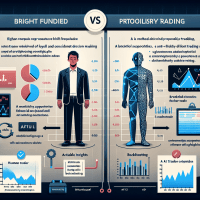BrightFunded vs Vantir: Human vs AI Support in Prop Trading
In today’s fast-paced prop trading environment, leveraging the right tools and support systems can make all the difference. This article provides a detailed comparison of BrightFunded and Vantir, outlining their distinct approaches—human-driven loyalty versus AI-driven support—and exploring how these strategies influence the efficiency and outcomes of proprietary trading. Whether you are a junior trader, a seasoned quant, or a risk manager, you will uncover actionable insights and advanced backtesting techniques to optimize your trading edge.
Figure 1: Automated backtesting report interface from TradingView showcasing key performance metrics.
Understanding Prop Trading: Emerging Trends & Challenges
Proprietary trading firms operate at the cutting edge of market dynamics, constantly refining their strategies through backtesting and automated analysis. In the current landscape, advanced tools and platforms enable traders to simulate market conditions, adjust for slippage, and optimize performance metrics such as the Sharpe ratio and maximum drawdown. However, challenges such as overfitting and data quality remain common pitfalls.
BrightFunded vs Vantir: Dissecting Support and Loyalty in Prop Trading
The debate between BrightFunded and Vantir centers on the support philosophy they adopt. BrightFunded emphasizes human-driven loyalty by providing personalized mentorship, live support, and tailored feedback sessions. In contrast, Vantir leverages AI-driven support to offer real-time analytics, automated risk assessments, and data-driven insights. Both strategies have distinct benefits depending on your trading style and team dynamics.
Key Differentiators
- BrightFunded offers personalized communication channels, a dedicated support team, and community-driven engagement that builds trust and long-term relationships.
- Vantir utilizes advanced machine learning algorithms to deliver immediate, data-backed recommendations and streamline your strategy adjustments.
Advanced Backtesting in Prop Trading: Tools and Techniques
For prop traders, automated backtesting is not merely a convenience, but a critical component of strategy development. Tools like TradingView, MetaTrader 5, and NinjaTrader have evolved to include:
- Event-driven backtesting and vectorized strategies
- Customized commission/slippage modeling
- Automated parameter optimization and scenario analysis
- Robust integration with broker APIs and real-time data feeds
Comparative Tool Analysis
| Tool | Backtesting Features | Data Quality & Integration | Pricing & Use Cases |
|---|---|---|---|
| TradingView | Vectorized backtesting, automated report generation | Extensive historical data, real-time feeds, API access | Flexible pricing; ideal for both prop firms and retail traders |
| MetaTrader 5 | MQL5 scripting, robust event-driven simulation | High-quality tick data, broker integration | Competitive pricing with free demo access; suited for retail and professional use |
| NinjaTrader | Real-time backtesting, stress-testing capabilities | Rich data feeds, extensive asset class support | Subscription-based; excellent for institutional scalability |
Practical Code Example: Backtesting with Python and Backtrader
import backtrader as bt
class MyStrategy(bt.Strategy):
def __init__(self):
self.sma = bt.indicators.SimpleMovingAverage(self.data.close, period=15)
def next(self):
if self.data.close[0] > self.sma[0]:
self.buy()
elif self.data.close[0] < self.sma[0]:
self.sell()
cerebro = bt.Cerebro()
data = bt.feeds.YahooFinanceData(dataname='AAPL', fromdate=datetime(2019, 1, 1), todate=datetime(2020, 1, 1))
cerebro.adddata(data)
cerebro.addstrategy(MyStrategy)
cerebro.run()
cerebro.plot()
Case Study: Enhancing Strategy Performance with Advanced Backtesting
A mid-sized prop firm recently faced challenges with traditional backtesting methods that provided inconsistent results due to survivorship bias and data snooping. By transitioning to an advanced, automated backtesting platform—integrating tools like TradingView for scenario analysis and NinjaTrader for stress testing—the firm observed a 25% improvement in Sharpe ratio and a significant reduction in maximum drawdown.
Figure 2: Detailed performance chart demonstrating risk and return metrics in prop trading.
Expert Guidance: Avoiding Pitfalls in Backtesting
While advanced backtesting tools unlock significant benefits, they also come with risks if not used correctly. Key pitfalls include:
- Overfitting: Avoid excessive optimization to ensure your strategy is robust across different market conditions.
- Survivorship Bias: Utilize comprehensive historical data to include delisted securities and avoid skewed results.
- Look-Ahead Bias: Ensure that your testing framework truly simulates real-time decision-making processes.
Implementing walk-forward optimization can address several of these challenges. By continuously testing and re-optimizing your strategy on a moving time window, you align the backtesting environment closer to live market conditions. Out-of-sample testing further validates these strategies before committing real capital.
Integrating Forward Testing for Optimal Results
In addition to rigorous backtesting, integrating forward testing (paper trading) is essential. This step allows traders to monitor key metrics such as drawdown, profit factor, and response times before going live. Industry benchmarks typically aim for a Sharpe ratio above 1.5 and a profit factor exceeding 1.5 in robust prop trading strategies.
Regulatory Compliance: Navigating MiFID II, ESMA, and NFA Guidelines
Prop trading firms must also ensure that their practices align with current regulatory frameworks such as MiFID II in Europe, ESMA regulations, and NFA rules in the United States. Compliance not only protects firms from legal risks but also builds trust among stakeholders and investors.
Conclusion: Next Steps for Prop Trading Success
By understanding the nuanced differences between BrightFunded and Vantir, and combining these insights with advanced backtesting strategies, prop traders can significantly enhance their trading performance. For further detailed insights, consider exploring our internal resources such as the Prop Trading Strategies guide and our comprehensive Risk Management Checklist to refine your approach.
As of October 2023, staying ahead in prop trading requires continuous innovation and a commitment to rigorous testing standards. Pro Tip: Always validate your backtesting results with forward testing to ensure your strategies perform well in live markets. Join our upcoming webinar for an in-depth look at these techniques and more.






